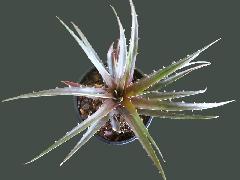Dyckia maracasensis
Click thumbnails for full size, scaled to a new window.
Dyckia maracasensis
Species Canna Brava, Maracas, Brazil. Named by Ule.



Dyckia maracasensis Ule, Bot. Jahbr. 42: 197. 1908.
Desc from S&D
Plant flowering 1 m or higher.
Leaves in a dense rosette, to 20 cm long;
sheaths short, suborbicular;
blades narrowly triangular, attenuate, pungent, densely lepidote beneath, laxly repand-serrate with curved spines 2 mm long.
Scape subangular, densely ferruginous-flocculose toward apex;
scape-bracts erect, the lower foliaceous and imbricate, the upper shorter than the internodes, lance-ovate with long narrowly triangular serrulate blades.
Inflorescence racemose or paniculate, ferruginous-flocculose;
primary bracts like the upper scape-bracts, much shorter than the long compressed bases of the branches.
Floral bracts broadly ovate, apiculate, finely serrate, slightly exceeding the stout 5 mm long pedicels;
flowers suberect or sometimes spreading and secund.
Sepals broadly ovate, obtuse, 6 mm long;
petals broadly elliptic, obtuse, 9 mm long, exceeding the stamens, yellow;
filaments connate for 2 mm above the common tube with the petals; ovary 4.5 mm long, style 1.5 mm long.
TYPE. Ule 7019 (holotype, B; photo 11439, F), Canna Brava, Maracas, Bahia, Brazil, Sep 1906.
DISTRIBUTION. On rocks, 1050 m alt, Bahia, Brazil. BRAZIL. BAHIA: Monte de Burro, Maracas, 19 Oct 1948, Foster 2459 (US).
Updated 09/08/22


